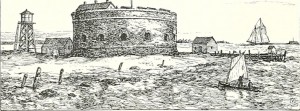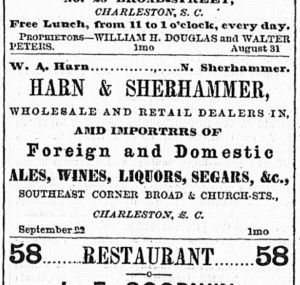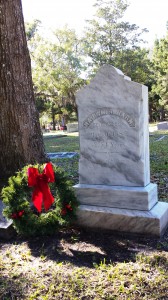Charleston, SC 1860…
The presence of a (now) foreign army on their land was untenable for the newly independent South Carolina. Upon succession, US. Army Major Robert Anderson evacuated Fort Moultrie after sabotaging the military hardware there and relocated all troops to Fort Sumter, isolated as it was by its location on an island in Charleston Harbor. William Harn was among the Union troops at Fort Sumter, while Kate’s family stayed with her father, Ordinance Sergeant James Skillen at Castle Pinckney, another much smaller harbor fort.
On December 27, 1860, months before the “first shots of the war” occurred at Fort Sumter, state militia attacked Castle Pinckney and seized the fortification without a fight, there being only James Skillen and Lieutenant R.K. Meade of the engineers present to protest. Captain Abner Doubleday, second-in-command to Major Anderson, called it “the first overt act of the Secessionists against the sovereignty of the United States.”
In his Reminiscences of Forts Sumter and Moultrie in 1860-‘61, Doubleday recalled the moment when a South Carolina militiaman spotted Kate Skillen, then 15 years old, “weeping bitterly at the ramparts” following the fall of Castle Pinckney. After he assured her that they meant her no harm she replied, “I am not crying because I am afraid…I am crying because you have put that miserable rag up there,” referring to the Palmetto flag the militia raised in place of the American flag.
Lieutenant Meade evacuated after exacting a promise from the militia that the Skillen family would be treated well, though we do not know exactly what happened to them during those days after the fort’s seizure. Meade returned to Fort Sumter where he, along with William Harn and the rest of the soldiers stationed there, suffered through the bombardment on April 12 and 13, 1861. After their evacuation to New York City, Harn reenlisted and earned a commission as a First Lieutenant, due to his exemplary service record prior to the war.
He went on to participate in most of the major battles in the east during the Civil War, including the Battles of Mechanicsville, Fredericksburg, Gettysburg, the Wilderness, and Appomattox Court House among others. By the Battle of Gettysburg, Harn commanded his own artillery regiment, the 3rd NY Independent Artillery. He progressed from First Lieutenant to Captain and earned the rank of Brevet Major for his meritorious service.
In 1864, during leave from his unit, Harn married his sweetheart, Kate Skillen. Following the war, the Harns returned to Charleston, SC where William owned a liquor store and bar before joining the Lighthouse Service. After serving aboard a lightship and at the Morris Island Range Lights, Harn moved the family to St. Augustine to serve as Head Lighthouse Keeper. As the head keeper, William had a 1st and 2nd Assistant working for him. The three keepers tended to the lighthouse and grounds and kept the light running continuously through the night. As of the move, the Harns had five daughters:
Ruby, born in 1864 in Rome, NY
Mollie, born in 1867 in Charleston, SC
Charlotte, born in 1868 in Charleston, SC
Katherine, born in 1870 in Charleston, SC
Ida, born in 1873 in Charleston, SC
Upon their arrival in St. Augustine, the Harns moved into the keepers’ house of the old lighthouse and lived there for a year before relocating to the current keepers’ house upon its completion. As the first head keeper family to live in the new house, the Harns saw many changes over William’s 14 years here as lighthouse keeper.
Perhaps the biggest change was the slow erosion of the old light station buildings, which were the only other permanent structures on Anastasia Island when the Harns arrived. The keepers’ log details the slow yet unstoppable encroachment of the ocean on the old lighthouse. On September 10, 1878, William reported that a “storm washed away the foundation from under the dwelling of the old lighthouse and the building tumbled over,” and gone was the house the Harns first inhabited. The old lighthouse held out until June 20, 1880 when the “old tower fell at 5 p.m.” due to a “very high tide.”
William also recorded two earthquakes during his tenure, on January 11, 1879, and August 31, 1886. According to the keepers logs, the first one caused “the building to shake and windows to rattle” while during the second, the “tower swayed in a violent manner.” Despite the rumblings, William reported no damage to the lighthouse or surrounding public buildings.
The Harn family saw several structural changes as well. On December 17, 1885, the keepers’ log records the transition from lard oil to mineral oil (kerosene). Kerosene was a much more efficient, useful fuel as it did not require heating like the lard oil, and it flowed better through the oil lantern wicks. In 1888, the Lighthouse Service replaced the original kitchens, placed in the light station courtyard, with new kitchens located much closer to the Keepers’ House.
In addition to the daily and nightly responsibilities of the lighthouse keepers, the interior and exterior of the lighthouse needed painting. Each year, the keepers painted some part of the lighthouse. In 1882, the keepers painted the “lantern frame and watch room.” In 1887, the exterior of the tower, with its black and white spiral stripes, received a new coat.
In 1882, the family welcomed the final addition to the family, Grace Harn. Unfortunately, during this time, William Harn suffered from tuberculosis. Kate Harn assisted her husband and the other keepers as necessary to continue the operation of the lighthouse. William’s health finally failed him and on May 31, 1889 at 1:00 am, he passed away. The local newspaper covered William’s funeral the next day, calling the services “very impressive, and…participated in by a large number of friends of the deceased.” The local Grand Army of the Republic Post remembered their fallen comrade with a small memorium stating…
“…in the death of Comrade Harn this post has lost a loyal member, the Government a faithful servant, the community an honest citizen, and the family a kind and loving father and a devoted husband. As a man, a soldier, and a comrade, none stood closer to [us] than William A. Harn.”
By June 4, the community had a petition “circulated urging the government to appoint Mrs. Harn as lighthouse keeper” to replace William. It was “extensively signed.” Due to this effort, Kate became 2nd Assistant and served for 6 months before she secured William’s military pension.The former 1st Assistant Keeper, Joseph Rantia became head keeper and Jerome Lopez, the 2nd Assistant moved into Rantia’s place.
In the early 1890s, Kate moved the family back to her home state of Maine, leaving behind many friends. The St. Augustine community kept track of the Harn girls through the years, even reporting on their lives including marriages and engagements. The September 15, 1927, edition of the St. Augustine Evening Record reported the death of Kate over 30 years after she moved away.
Paul Zielinski is Director of Interpretation for the St. Augustine Lighthouse & Museum. He received his master’s degree in Public History from the University of West Florida and joined the lighthouse family in 2011.




